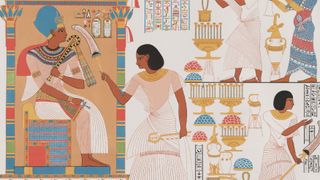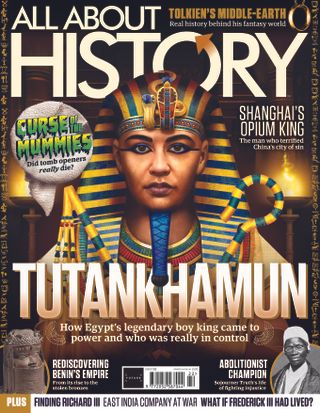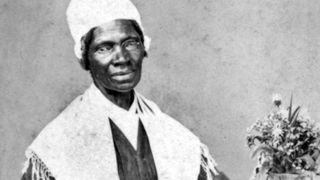The real life of Tutankhamun uncovered in All About History 122
Inside All About History 122: Discover what Tutankhamun, boy king of Egypt, was really like.

In All About History issue 122, on sale now, uncover the real story behind Ancient Egypt's legendary boy king, Tutankhamun. As the world marks the 100th anniversary of his tomb being discovered by Howard Carter and his team in 1922, All About History looks into the life of the young pharaoh.
Learn how he came to inherit the throne of Egypt and the turmoil of the kingdom he inherited from his 'heretic' father. How did the boy king rule and who was really in charge of the affairs of state?
You can find the answers to these questions and many more in the latest issue of All About History.










Also in All About History 122, dig into the popularity of mummy curse myths, learn about the activism of Sojourner Truth, find out what history inspired J.R.R. Tolkien's Middle-earth and delve into the art and culture of the Kingdom of Benin.
Related: Read a free issues of All About History
Plus, Philippa Langley discusses the hunt for Richard III's remains to mark ten years since her headline-grabbing discovery, and All About History reveals the Shanghai gang lord who struck fear into the hearts of all who crossed his path. It's all in All About History 122.
Tutankhamun: Life of the boy king

Tutankhamun – originally called Tutankhaten – was born around 1329 BCE. This was a time of great upheaval in Egypt, when the prince’s father, King Akhenaten, had reformed the country’s millennia-old traditions. With Queen Nefertiti, he had turned his back on the gods in favor of an obscure deity the Aten, or sun disc. As Akhenaten’s reign progressed, the god Amun, king of the gods, was targeted for attacks. The king’s followers smashed Amun’s statues across Egypt and scratched away his name from monuments. Amun represented all that was hidden, so Akhenaten perhaps regarded him as the antithesis of the Aten’s all-encompassing, life-giving light.
But as the years passed, other gods were attacked too. To symbolize Egypt’s new beginning, Akhenaten moved the royal court to a newly built city in the desert, which he called Akhetaten – the Horizon of the Aten – today called Amarna. For years, people hauled blocks of stone from nearby quarries to build its temples, and worked in the intense heat making mud bricks for elite villas and palaces. The homes of the poor grew around these villas, and as the city developed, its workers died in large numbers; malnourished, overworked, and often young, they were buried on the outskirts of the city and forgotten. They paid the price for Akhenaten’s dreams.

Subscribe to All About History today and receive a bundle of 4 ancient history specials worth approximately $46 for FREE.
With this dramatic shift in religious devotion, Egypt’s art style changed too. Directed by the king, the Amarna artists produced statues and carvings quite unlike any that came before or after him. Despite wearing the traditional regalia of a pharaoh, Akhenaten was carved with a round belly and spindly legs and arms – far from the youthful, muscular and fit bodies that pharaohs typically chose for their official art. Temples changed too. Gone were their dark and mysterious sanctuaries, where the gods’ statues stood in shrines, awaiting gifts and praise from priests. Temples to the Aten were open to the sky, embracing the sun’s rays, which reached down to touch hundreds of offering tables laden with food and drink. This was the new Egypt in which Tutankhamun grew up.
Read more in All About History 122.
Sojourner Truth

Sojourner Truth (1797 – 1883) was born enslaved in the Hudson River Valley in New York. She was named Isabella Baumfree, daughter of Elizabeth and James Baumfree, in the Low Dutch community that populated the region. It is little known that Isabella was actually a native Dutch speaker who knew no English until the age of nine. After being forced to learn English, she nonetheless continued to speak the language with a marked Dutch accent for the rest of her life. Isabella had heard that her mother had had 13 children, but she hardly knew any of them, as most of her siblings had either been sold away before she was born or in her infancy before she could remember. Her family, particularly her mother, lived in great terror of this constant separation and loss.
When Isabella was aged nine, her master died and her family was separated once more. Her ill and aging mother and father were granted freedom following a lifetime of work. Meanwhile Isabella was sold at an auction with a flock of sheep for $100. By the age of 13 she had been sold and moved around a total of three times and had had four owners. These were hard years for Isabella. The first of these owners, Neely, beat her cruelly with rods and she was often punished for not understanding instructions and commands in English.
Learn more about the life of Sojourner Truth in All About History 122.
History behind Middle-earth

“I am historically minded. Middle-earth is not an imaginary world" — J.R.R. Tolkien
The world of Middle-earth is the fictional setting of J.R.R. Tolkien’s celebrated works The Hobbit, The Lord of the Rings and The Silmarillion, but within its fiction are many elements of older, historic works. Tolkien was famously a passionate linguist, inventing a number of languages as he built his fantasy world, but he was also a medievalist and a lover of Anglo-Saxon, Germanic and Nordic mythology, all of which fed into his new creation. Just as the languages of Europe fed into Middle-earth, so too did the myths and history of Europe, from the ancient past, even up to his own time, as we’ll explore in this feature. Tolkien soaked it all up and fed it back into his writing. Even the name, as Tolkien pointed out himself, was a modernization of an Old English word, ‘middel-erd’, “an old word for the inhabited world of men, the oikouménē.”
Read more about Tolkien's inspirations for Middle-earth in All About History 122.
Sign up for the Live Science daily newsletter now
Get the world’s most fascinating discoveries delivered straight to your inbox.

Jonathan is the Editor of All About History magazine, running the day to day operations of the brand. He has a Bachelor's degree in History from the University of Leeds. He has previously worked as Editor of video game magazines games™ and X-ONE and tech magazines iCreate and Apps. He is currently based in Bournemouth, UK.